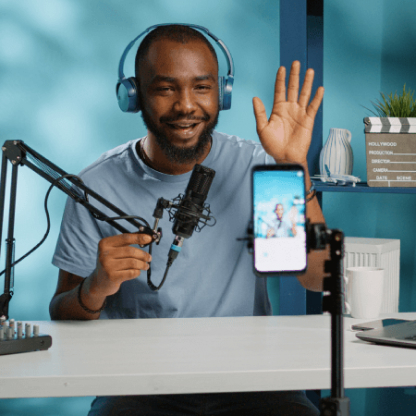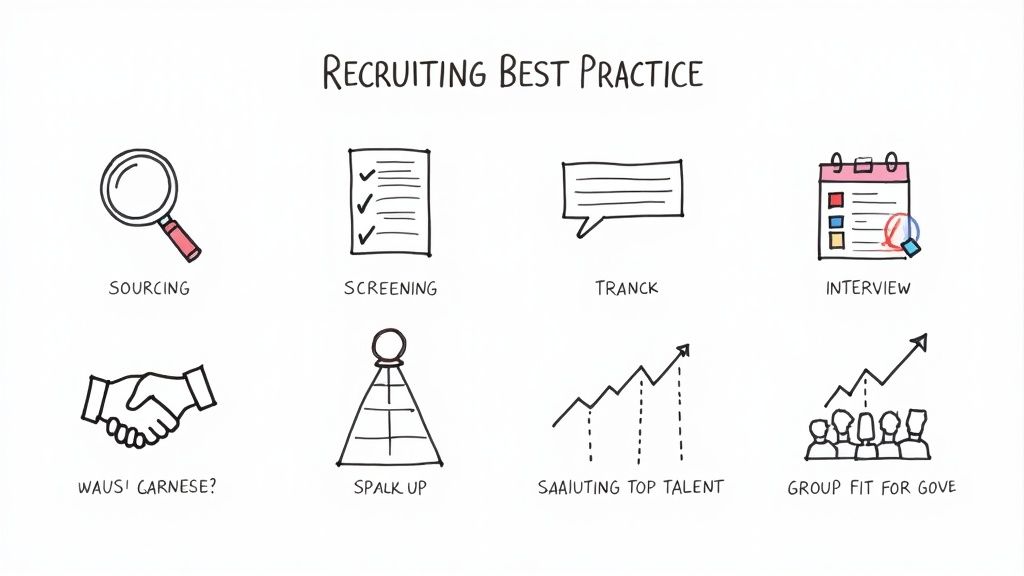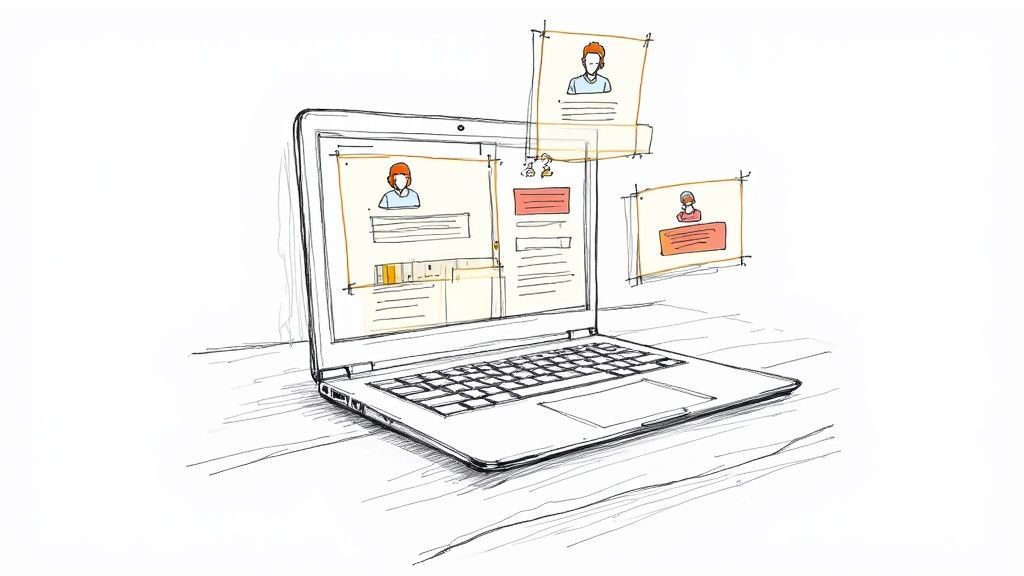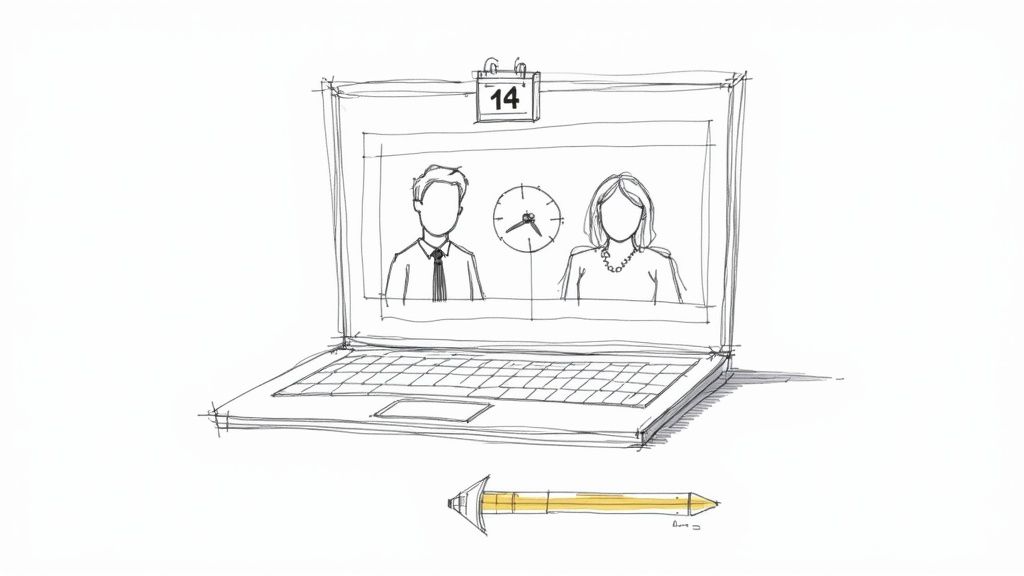Alright, let's talk. You've polished your resume until it shines and rehearsed your answers until you can recite them in your sleep. But there's one last boss to beat: the webcam. Suddenly, your closet feels like a trap. Does this shirt make me look like a blurry blob? Will this color clash with my IKEA bookshelf? I've been there, staring into the digital abyss, wondering how to look like I have my life together from the waist up.
Turns out, deciding what to wear on a video interview is less about high fashion and more about psychological warfare—against bad lighting, distracting patterns, and the sheer awkwardness of talking to a screen. Hope you enjoy second-guessing every clothing choice you’ve ever made, because that’s now part of the interview prep.
Or, you could just use this guide. I’ve made the mistakes so you don’t have to. For many roles, simply mastering the business casual dress code is half the battle, but there are screen-specific nuances that can make or break your first impression. Here are eight no-nonsense rules for dressing for success when your interview is just a few clicks away.
1. Dress One Level Above the Position
When deciding what to wear on a video interview, there's one simple rule that has never failed me: dress one level above the job you're applying for. This isn't about being overly formal or misreading the room. It’s about signaling respect for the opportunity and showing you’re serious. You're not just another Tuesday morning calendar alert; you’re a potential asset, and you look the part.
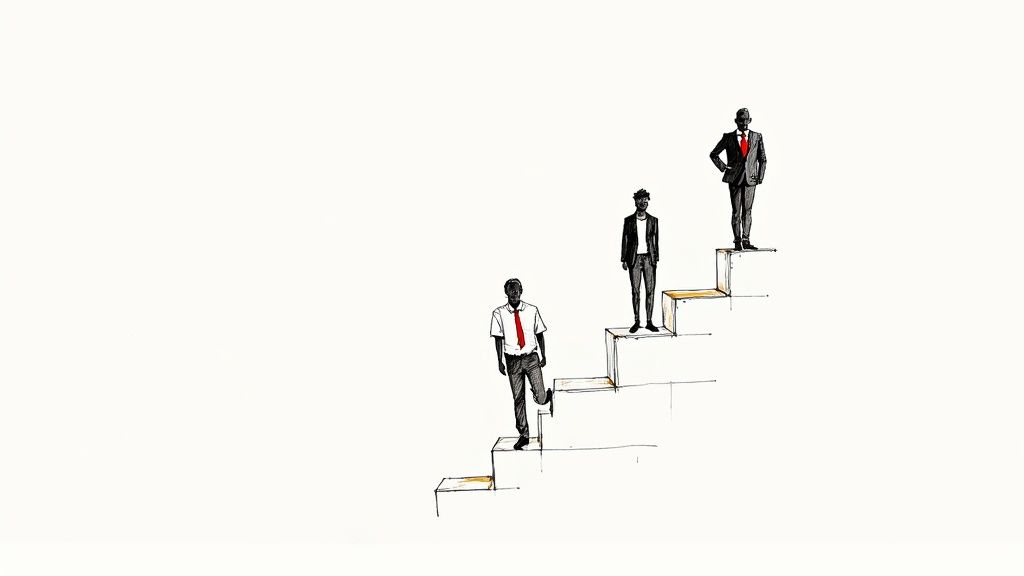
The goal is to look polished and intentional, not like you're about to attend a gala. It’s a subtle elevation that communicates professionalism without creating a culture clash. After all, nobody ever got rejected for looking too put-together, but I've heard plenty of hiring managers grumble about candidates who looked like they just rolled out of bed.
How to Calibrate Your "Plus-One" Outfit
Not sure what "one level up" looks like in practice? Let's break it down.
- For a Casual Startup (T-shirts & Hoodies): Elevate to a clean, well-fitting button-down shirt or a smart polo. You don't need a tie, but swapping the hoodie for a structured sweater or a casual blazer shows you mean business.
- For a Business Casual Office (Polos & Slacks): This is where a blazer becomes your best friend. Pair it with a collared shirt or a refined blouse. It’s the perfect step-up that says "I understand your culture and I'm ready to contribute."
- For a Formal Corporate Environment (Business Professional): If the standard is a suit and tie, make sure your suit is perfectly tailored and your accessories are sharp. Think of it as wearing your "A-game" suit, not just any suit.
Key Insight: Dressing slightly more formally than required is a non-verbal cue that you take the interview process seriously. It's a low-effort, high-impact way to make an excellent first impression before you’ve even said a word. When in doubt, it’s always better to be the best-dressed person on the call.
2. Choose Solid, Professional Colors
When it comes to what to wear on a video interview, your color choice is doing more heavy lifting than you think. The wrong color can be distracting, wash you out, or even create weird visual effects on camera. The right one makes you look sharp, focused, and professional. Sticking to solid, classic colors is the safest and most effective strategy to ensure the focus stays on you and your qualifications, not your wardrobe.
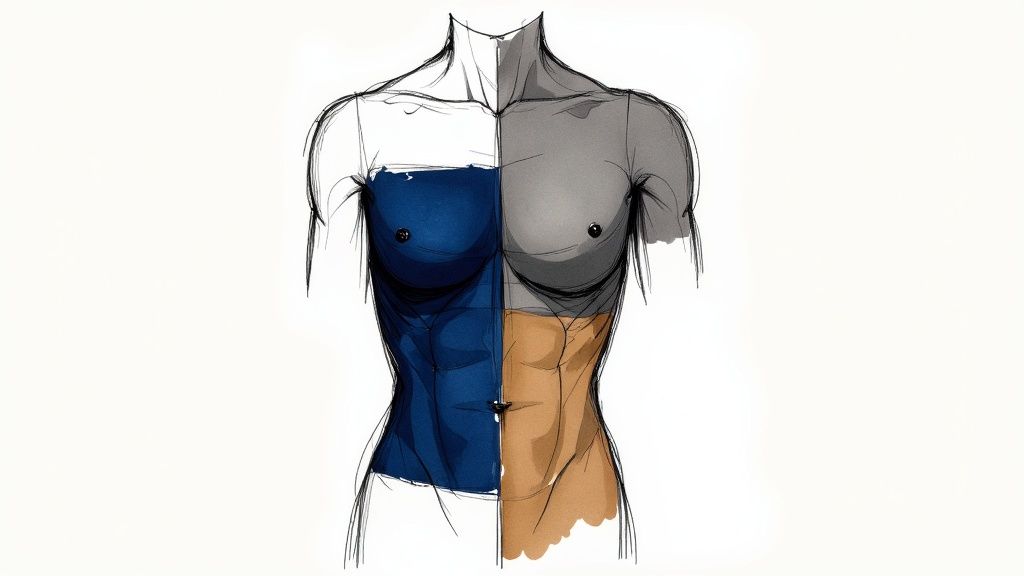
Think of your screen as a small stage where you are the main event. Busy patterns like tight stripes or houndstooth can create a dizzying moiré effect on camera, while neon colors can reflect onto your face and distract the interviewer. Solid navy, charcoal, muted jewel tones, or a crisp white or black create a clean, professional canvas that lets your skills shine. It’s a simple trick that communicates stability and confidence.
How to Pick Camera-Friendly Colors
Choosing the right solid color isn’t just about avoiding patterns. It's about strategic selection to look your best on screen.
- Classic Professionals: Navy blue, charcoal gray, and black are the undisputed champions. A navy blazer with a white shirt is a timeless combination that projects authority and trustworthiness without being overpowering.
- Approachable Alternatives: Muted earth tones or softer blues and greens can feel more approachable while still looking professional. Think olive green, burgundy, or a dusty blue sweater. These work exceptionally well for business casual settings.
- Contrast is Key: Pay attention to your background. If you have a light-colored wall behind you, a darker top will help you stand out. If your background is dark, a lighter color will prevent you from blending in.
Key Insight: Your outfit’s color palette is a critical part of your non-verbal communication in a video interview. Solid colors remove visual distractions, helping the interviewer focus on your face, expressions, and what you're saying. Always do a quick camera test to see how your chosen color looks under your lighting before the call starts.
3. Ensure Proper Fit and Comfort
Let’s be honest: an ill-fitting blazer is the physical equivalent of a distracting pop-up ad. If you're constantly fidgeting, pulling at your collar, or adjusting your sleeves, you’re not just annoying yourself; you’re broadcasting anxiety and a lack of preparation. The best outfit for a video interview is one you can forget you’re wearing, allowing your skills and personality to take center stage.
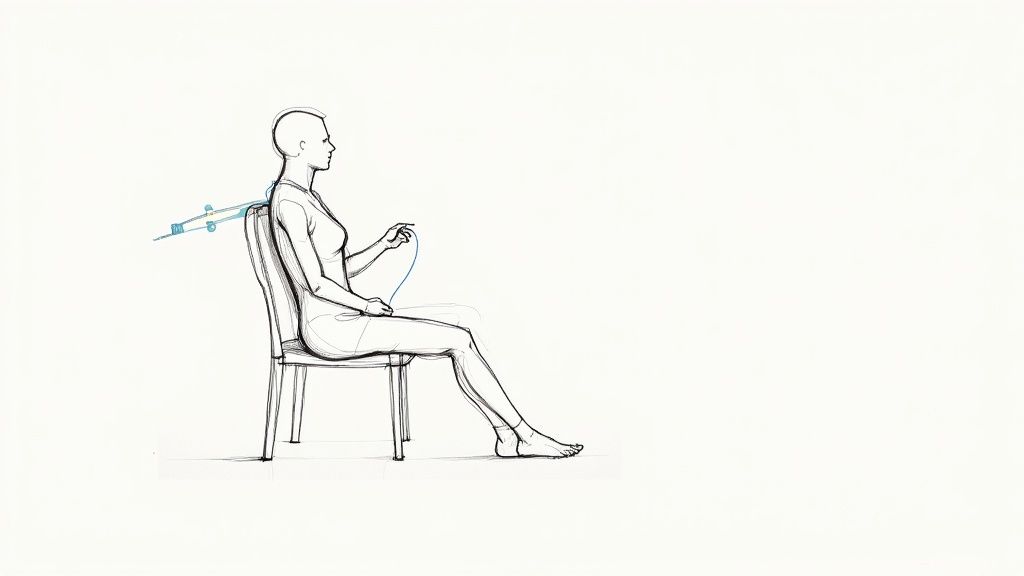
Clothing that fits well looks sharp and intentional on camera. A shirt that bunches at the shoulders or a blouse with a gaping neckline can make you look disheveled, even if it’s a high-end brand. Comfort is just as crucial. If you're physically uncomfortable, it will show on your face and in your body language, undermining the confidence you're trying to project.
How to Nail the Fit and Comfort Test
You wouldn't show up to an interview without preparing your answers, so don't show up without test-driving your outfit. Here’s a simple checklist.
- The Sit-Down Rehearsal: Try on your complete top-half outfit and sit in your interview chair. Does anything pull, bunch, or ride up? A blazer that looks great standing might become a boxy mess when you're seated.
- The Lean-In Check: Lean toward your camera as you would to make a point. Does your neckline remain appropriate? Ensure nothing becomes too revealing or gapes awkwardly. This is a common mistake that can instantly derail an otherwise professional appearance.
- Fabric and Wrinkle Resistance: Opt for fabrics with a bit of structure or stretch that resist wrinkling. Sitting for an hour can turn a crisp linen shirt into a mess, but a quality cotton blend or knit will maintain its shape and keep you looking polished from start to finish.
Key Insight: Your outfit's fit directly impacts your non-verbal communication. When you feel comfortable and confident in what you're wearing, you can focus all your energy on the conversation, not on a restrictive collar. It’s a foundational step that sets the stage for a successful interview, a topic you can explore further to master your on-demand video interview.
4. Mind Your Neckline and Necklaces
When you’re thinking about what to wear on a video interview, the area from your shoulders up is prime real estate. The wrong neckline or a distracting necklace can pull focus exactly where you don't want it. Your goal is for the hiring manager to remember your brilliant answers, not the glare coming off a chunky piece of jewelry or a neckline that looks awkward on camera.
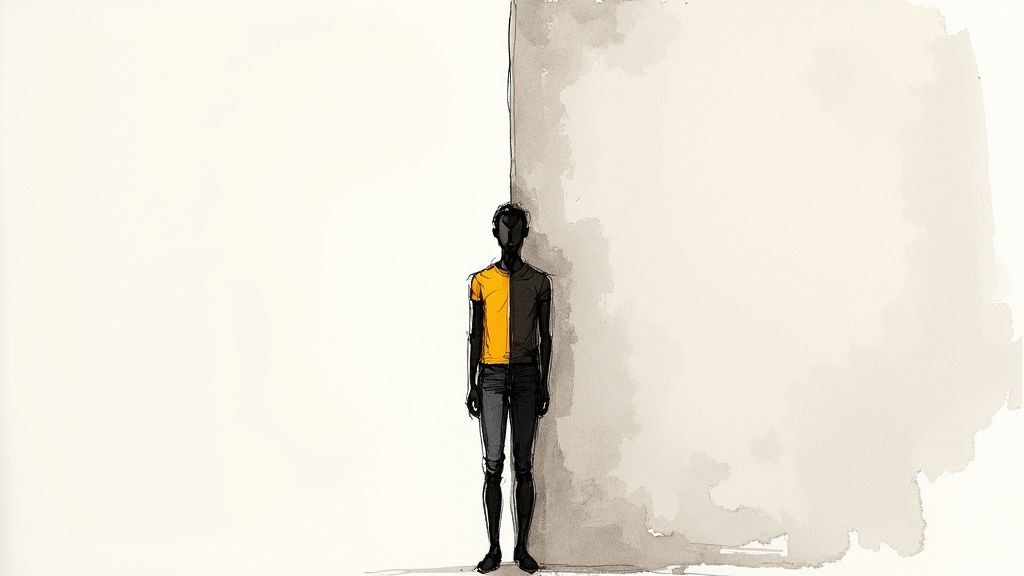
This isn’t about being overly conservative; it’s about controlling the narrative. You want to frame your face professionally, and that means choosing simple, classic lines that work with the camera, not against it. A well-chosen neckline and minimal accessories ensure that you look polished and the spotlight stays on your qualifications. After all, you’re selling your skills, not auditioning for a jewelry commercial.
How to Frame Your Face for the Camera
Not sure how to select a camera-friendly neckline and accessories? Let’s get specific.
- Choose Classic Necklines: Opt for a crew neck, a modest scoop neck, or a collared button-down shirt. These options are universally professional and avoid any on-screen awkwardness. Steer clear of very low-cut tops or high turtlenecks, which can look bulky or create a "floating head" effect.
- Keep Jewelry Simple and Strategic: If you wear jewelry, make it an understated accent. A simple chain, a small pendant, or classic pearl/stud earrings are perfect. Avoid anything that dangles, clinks against your mic, or reflects light harshly into the camera.
- Test Your Look: Always do a quick video test. See how your neckline appears when you’re sitting upright and when you lean forward. A top that looks fine standing might become inappropriate once you're seated at your desk. Check for any jewelry glare or distracting movements.
Key Insight: Your neckline and accessories create the visual frame for your face on screen. By keeping them clean, simple, and professional, you eliminate potential distractions and ensure the interviewer's focus remains on your expressions and your words. It’s a simple detail that signals you understand the nuances of virtual communication.
5. Pay Attention to Grooming and Hair
Your outfit could be perfect, but if your grooming is an afterthought, the entire professional image falls apart. Paying attention to your hair and overall tidiness is a non-negotiable part of preparing for a video interview. It’s the final polish that shows you’re meticulous and detail-oriented, not just someone who threw on a nice shirt five minutes before logging on.
Think of it this way: your head and shoulders are the main event on a video call. Unkempt hair or a messy beard can be incredibly distracting, pulling the interviewer's focus away from your brilliant answers. A clean, put-together presentation ensures that your qualifications and personality are what shine through, not a stray cowlick.
How to Sharpen Your On-Screen Grooming
Getting your grooming right for the camera isn't complicated, but it does require conscious effort. Here’s a simple checklist to follow.
- For Shorter Hair: Ensure you have a clean, well-trimmed haircut. Style it so it stays in place and won't require constant adjustment. Fidgeting with your hair can be read as nervousness or a lack of confidence.
- For Longer Hair: Style it professionally so it's out of your face. A neat ponytail, a low bun, or pulling it back from your face are all excellent, distraction-free options. The goal is to keep your face clearly visible.
- For Facial Hair: If you have a beard or mustache, make sure it is neatly trimmed and groomed. A well-maintained look appears intentional and professional, while a scruffy one can look careless.
- For Makeup: If you wear makeup, aim for a natural, polished look that enhances your features without being distracting. To maintain a consistent and professional appearance throughout your video interview, it's essential to understand how to make your makeup last all day.
Key Insight: Excellent grooming is the ultimate sign of preparedness. It communicates that you care about the details and respect the interviewer's time. A hairstyle that is neat and stays out of your face ensures the focus remains on you and your professional qualifications, not on distracting adjustments.
6. Consider Your Background and Contrast
Your outfit isn't chosen in a vacuum. When deciding what to wear on a video interview, you're not just dressing yourself; you're styling a scene. The goal is to be the main character, not an extra who blends into the wallpaper. If your shirt is the exact same shade of beige as the wall behind you, you risk becoming a floating head. Not the power move you were going for.
Creating a clear visual separation between you and your background is non-negotiable. It makes you look sharper, more defined, and keeps the interviewer’s focus where it belongs: on you. A thoughtful contrast shows you’ve considered every detail, signaling a level of preparedness that extends beyond your resume. It's a subtle art, but it makes a massive difference in how professionally you come across on screen.
How to Master On-Screen Contrast
Not sure how to create that perfect visual pop? It’s simpler than you think. Let's frame this out.
- Light Background (White, Beige, Light Gray Wall): Go for richer, deeper colors. A navy blazer, a charcoal sweater, or a jewel-toned blouse will create a strong, professional silhouette. This is the easiest combo to get right.
- Dark Background (Bookshelf, Dark Painted Wall): This is your chance to wear lighter colors. A crisp white or light blue collared shirt, or a soft pastel blouse, will prevent you from disappearing into the shadows.
- Busy Background (Art, Plants, Decor): Keep your outfit simple and solid. Avoid patterns, stripes, or complex textures that will compete with what’s behind you. Let your background add personality while your outfit anchors the scene with professionalism.
Key Insight: Your outfit and background are a team. They need to work together to make you look good. Always do a "dress rehearsal" in front of your camera with your planned lighting to see how the colors interact. This simple test prevents last-minute scrambles and ensures you present a polished, intentional image. For more tips on optimizing your on-screen presence, check out these great virtual interview tips.
7. Dress Completely, Not Just from the Waist Up
It's the oldest joke in the remote work playbook: the "business on top, party on the bottom" video call outfit. While it might sound efficient, relying on this strategy for an interview is playing with fire. Dressing completely, from head to toe, is about more than just avoiding the embarrassment of having to stand up unexpectedly; it’s a psychological trick to get your head in the game.
When you're fully dressed in a professional outfit, your brain gets the signal that it's time to perform. It subtly changes your posture, your body language, and your overall mindset. You sit up straighter, you feel more confident, and you project an air of preparedness that simply can’t be faked when you’re secretly wearing pajama pants.
How to Build a "Camera-Proof" Outfit
Getting fully dressed doesn't mean you have to be uncomfortable. It's about completing the professional uniform to fully step into the role.
- Mind Your Bottom Half: Even if you’re sure you’ll be seated, wear professional slacks, a skirt, or tailored trousers. The simple act of putting them on switches your brain from "lounge mode" to "work mode." You never know if you'll have to stand to adjust a curtain or grab a document.
- Don't Forget Footwear: This might sound extreme, but your shoes affect your posture even when you're sitting. Slipping on a pair of professional shoes helps ground you and encourages a more upright, engaged posture compared to being barefoot or in slippers.
- Coordinate the Full Look: Ensure the entire outfit works together. This mental checklist reinforces your preparation and eliminates any last-minute "what if" anxieties. If you look and feel like a cohesive professional, you're more likely to act like one.
Key Insight: Your mental state is directly linked to your physical state. Dressing in a complete interview outfit is a powerful psychological cue that tells your brain, "This is important. Be sharp." It’s an easy way to boost your confidence and ensure you project professionalism, no matter what happens off-camera.
8. Prepare Backup Options and Do a Test Run
You’ve picked the perfect outfit, but have you actually seen it on camera? What looks fantastic in the mirror can look disastrous under your specific desk lamp. That's why a full dress rehearsal isn't optional; it's non-negotiable. Not testing your outfit is like shipping code without running it first, a rookie mistake that can have embarrassing consequences.
The goal is to eliminate any day-of surprises, from a shirt color that washes you out to a pattern that creates a bizarre strobing effect on screen. Having a backup ready to go ensures that a last-minute coffee spill or a sudden realization that your shirt clashes with your background won’t send you into a panic. This foresight shows you’re a planner, someone who anticipates problems and solves them proactively.
How to Run Your Pre-Interview Tech Check
Don't just glance in the mirror. A proper test run is about seeing exactly what the interviewer will see. Here’s how to do it right.
- Record Yourself: Open your video conferencing app and record a one-minute video of yourself answering a practice question. Watch it back critically. Does your collar sit funny? Does the fabric wrinkle strangely when you lean forward?
- Check Your Lighting: Test your outfit at the same time of day your interview is scheduled. Morning light is very different from afternoon light, and it can dramatically change how colors and textures appear on camera.
- Test for Moiré Patterns: Small, tight patterns like thin stripes or houndstooth can create a distracting visual distortion on screen known as a moiré pattern. If you see a weird shimmering effect, swap that item out immediately. A solid color is always a safer bet.
Key Insight: Your interview performance is only as good as your preparation. A technical dress rehearsal confirms your outfit looks professional on screen and that you have a solid Plan B. It’s a simple step that eliminates variables, allowing you to focus on what matters: landing the job. For more tips on getting ready, check out this guide on how to prepare for a video interview on asyncinterview.io.
Key Factors for Video Interview Attire: 8-Point Comparison
| Item | Implementation Complexity 🔄 | Resource Requirements ⚡ | Expected Outcomes 📊 | Ideal Use Cases 💡 | Key Advantages ⭐ |
|---|---|---|---|---|---|
| Dress One Level Above the Position | Moderate – requires company research | Moderate – appropriate attire needed | Polished, respectful appearance, positive impression | Interviews in varying company cultures, formal roles | Demonstrates respect, cultural awareness, professionalism |
| Choose Solid, Professional Colors | Low – select solid professional colors | Low – use existing wardrobe | Clean, distraction-free appearance on video | Video interviews, formal and corporate settings | Conveys reliability, photographs well, minimal distractions |
| Ensure Proper Fit and Comfort | Moderate – try on and test outfits | Moderate – may need tailored clothes | Increased confidence and comfort, polished look | Extended interviews, video calls | Enhances confidence, prevents distractions, allows gestures |
| Mind Your Neckline and Necklaces | Low – select appropriate necklines and minimal jewelry | Low – choose suitable tops and accessories | Professional, focused appearance on camera | Close-up video interviews | Minimizes distraction, frames face, shows professionalism |
| Pay Attention to Grooming and Hair | Moderate – grooming and styling effort | Low to moderate – styling tools/products | Professional and neat appearance on camera | All interview types | Creates positive impression, reduces distractions |
| Consider Your Background and Contrast | Moderate – coordinate outfit and background | Low – select clothing/background accordingly | Clear visual contrast, professional video presence | Virtual interviews with varying backgrounds | Maintains focus, prevents blending, enhances professionalism |
| Dress Completely, Not Just from the Waist Up | Moderate – full outfit preparation and coordination | Moderate – complete attire required | Boosted confidence and preparedness | Video interviews with possible movement or on-site | Prevents embarrassing moments, enhances mindset, body language |
| Prepare Backup Options and Do a Test Run | High – requires multiple outfits and technical testing | Moderate to high – time and equipment needed | Mitigated wardrobe risks, optimized video appearance | Important/high-stake video interviews | Ensures readiness, increases confidence, prevents emergencies |
Stop Worrying About Your Shirt and Start Nailing the Interview
Let’s be honest. The goal here isn't to land on the cover of Vogue. It's to remove your outfit as a potential distraction. You’re aiming for a look so seamlessly professional that the interviewer forgets it entirely within the first 30 seconds, leaving them free to focus on your brilliant answers, not the weird pattern on your shirt that’s making their screen buzz.
Think of it this way: your skills, experience, and personality are the main event. Your clothing is just the stage crew. Its job is to be invisible, effective, and supportive, making sure the spotlight stays exactly where it belongs: on you. By following the guidelines we’ve laid out, you are essentially clearing the runway for your qualifications to take flight. The best outfit for a video interview is one you can put on, test, and then completely forget about the second you click "Join Meeting."
Key Takeaways to Lock In
Before you close this tab and start rummaging through your closet, let’s boil it down to the absolute essentials. If you remember nothing else, remember this:
- Solids are your best friend. Simple, solid colors like blues, grays, and earth tones project confidence and don't fight with the camera. Ditch the busy patterns and blinding whites.
- Comfort equals confidence. A collar that’s too tight or a fabric that makes you itchy is a guaranteed distraction. Choose something that fits well and feels good, so you’re not fidgeting on screen.
- The waist-up rule is a myth. Dress the part completely. You never know if you'll need to stand up unexpectedly. Plus, dressing fully in professional attire mentally prepares you for the interview in a way that pajama pants just can't.
- Always do a test run. Fire up your camera in the exact lighting and spot you'll use for the interview. What looks great in your mirror might look completely different on screen. A five-minute tech check can save you from a major wardrobe malfunction.
Ultimately, mastering what to wear on a video interview isn’t about fashion; it’s about psychology. It’s about presenting a polished, non-distracting visual that lets your professional value shine through. You’re controlling the narrative from the moment the camera turns on, ensuring the first impression is one of competence, preparation, and respect for the opportunity. Now, go pick out that killer outfit and get ready to land the job.
Tired of worrying about candidate no-shows and endless scheduling conflicts on top of everything else? Async Interview streamlines the entire pre-screening process with one-way video interviews, so you can focus on evaluating talent, not coordinating calendars. See how our platform helps you identify top candidates faster at Async Interview.
